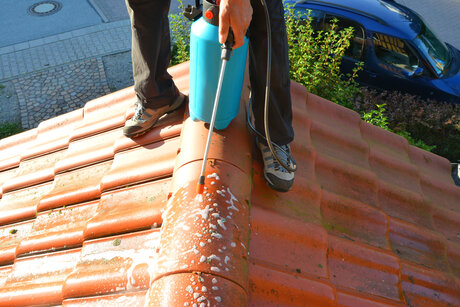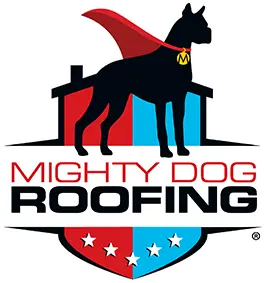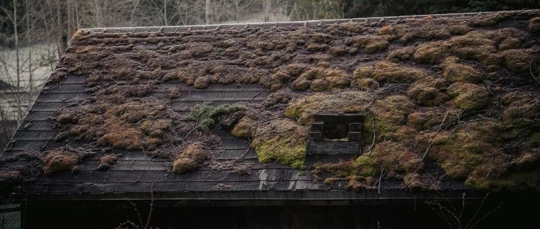The Best Way to Safely Remove Moss from Your Roof
Table of Contents
- Is Moss Bad for Your Roof?
- Why is Moss Bad for Shingles?
- Methods You Shouldn't Use to Remove Moss From a Roof
- Moss Removal Products and DIY Solutions
- How to Remove Moss From Roof Tiles Yourself
- Four Tips to Keep Moss Off Your Roof
- Contact Us
Protect Your Roof from its Stubborn Enemies - Moss and Algae
Moss may seem charming, especially on an old, weathered roof. But you do not want to let roof moss linger on your shingles, especially if you live in a wet climate or have asphalt shingles.
Is Moss Bad for Your Roof?
Yes, moss can damage your roof.
Moss absorbs moisture (like a sponge) and creates a constantly damp environment under the shingles. This trapped moisture fuels the growth of organisms that can break down the shingles themselves.
The moisture can also seep beneath the shingles, causing the wooden structures of your roof to rot. This hidden damage can lead to leaks, structural problems, and expensive roof repairs down the road. Over time, moss can also cause black streaks on your roof and mold growth.
The good news is that moss and moss spores are relatively easy to remove with the right tools and the help of professional roofers.
Why Is Moss Bad For Shingles?
The main reason moss and algae growth is terrible for shingles is that it can hold moisture against the roof surface and damage your roof.
This moisture can cause the shingles to deteriorate and shorten the lifespan of your roofing systems. In addition, as the moss decomposes, it can form an acidic solution that will eat away at the asphalt in your shingles.
Another problem with roof moss is that it can prevent rain and melting snow from draining properly through the gutters. Poor drainage can lead to water damage and leaks in your roof.
Moisture Exposure Can Damage Shingles
You may have heard of nature enthusiasts using moss as a natural sponge in a pinch because moss is excellent at absorbing and holding water. Unlike a sponge, however, moss doesn't release moisture quickly. Rather than using a root system for nutrients and water, moss uses its leaves, meaning it can live on your shingle roof indefinitely.
While this may be beneficial in some situations, it's not suitable for your shingles. When moss holds moisture against your shingles, it can cause the asphalt to deteriorate and break down.
High humidity or frequent rainfall will accelerate this process. Over time with subsequent rainfall, the moss will cause the shingles to deteriorate, leading to leaks and water damage.
Moss Can Lift Shingles
In addition to holding moisture against the shingles, moss can lift them as it grows underneath the shingle.
The lifting of shingles can cause problems in two ways. First, it creates an entry point for water and moisture, leading to leaks and water damage. Second, it makes your roof more susceptible to wind damage. If you have wood shingles, it can also lead to wood rot.
Methods You Shouldn't Use To Remove Moss From A Roof
You should avoid a few methods when removing moss from your roof. Adequately installed shingles should be sturdy, but they aren't made to withstand vigorous contact. These methods can damage your shingles or cause other problems.
DON'T Aggressively Scrub Moss From Shingles
You may be tempted to grab a stiff brush and scrub the stubborn moss away, but this is a bad idea.
Not only will it be difficult to remove all the moss this way, but you could also damage your shingles in the process.
The abrasive bristles of the scrub brush can wear down the asphalt or break off granules, leaving your shingles vulnerable to water damage. In addition, scrubbing too vigorously can cause the shingles to lift, creating an entry point for moisture.
DON'T Use A Pressure Washer
Another method you should avoid is pressure washing.
While it may seem like an excellent way to blast the moss away, the high-pressure stream of water can damage your shingles and the adhesive used to secure them to your roof.
You want to avoid eroding the asphalt from the shingles, as this will leave them vulnerable to water damage and UV rays, lowering the lifetime of your roof and potentially voiding your warranty.
DON'T Use Harsh Chemicals
There are a variety of chemicals you can use to kill moss from places like sidewalks and driveways, but most of them are bad for your roof.
Harsh chemicals like chlorine bleach and vinegar can damage the asphalt in your shingles, making them more susceptible to water damage and deterioration. In addition, using chemicals on your roof can be dangerous.
Many of these chemicals are not safe to use in nature as they may leak into groundwater or harm plants and animals. In addition, applying them to your roof can result in runoff that could damage your landscaping or harm local wildlife.
Moss Removal Products And DIY Solutions
What Kills Moss on Your Roof?
Below are several cleaning solutions that, when applied correctly, can kill moss on your roof:
- Store-bought: Moss cleaner solutions
- DIY Option #1: Bleach and trisodium phosphate mixed with water
- DIY Option #2: Dish soap (Dawn works great!) and horticultural oil mixed with water
- DIY Option #3: White vinegar and salt mixed with water
Continue reading to learn how to use these moss killers on your roof.
Pre-Made Moss Cleaners And Removers
Various products are available to clean moss from your roof without damaging the shingles. These cleaning products come in liquid and granular forms and can be found at most home improvement stores.
When using a pre-made moss removal product, follow the directions on the label to help you avoid damaging your shingles or harming your landscaping.
Make Your Own Moss Remover
If you don't have an asphalt roof, you can make your own diluted moss removal solution using safe ingredients for most roofing materials.
To make your moss remover, you can mix:
- 1 gallon of water
- Up to 1 quart of bleach (start small)
- 1/4 cup of heavy-duty cleaner like trisodium phosphate
Be careful not to mix any ammonia cleaner with bleach, as this can create a toxic compound that could kill you. If using these chemicals on your roof, do not simply pour them on the moss, creating runoff. The safest way to apply your solution is with a sprayer like you'd use for a weed solution, but do not reuse containers that previously held other chemicals.
Remember to label any mixtures you create to avoid problems down the road, and once you're done, safely dispose of the mix.
A More Eco-Friendly Moss Remover
If you want to avoid using harsh chemicals on your roof, you can try a few eco-friendly alternatives.
One popular method is to mix:
- 1 gallon of water
- 1/4 cup of dish soap
- 1/4 cup of horticultural oil like mineral oil or neem oil
You can also add in a few tablespoons of baking soda to act as an abrasive. You can apply this mixture with a pump sprayer and let it sit for a few hours before rinsing it away.
Another eco-friendly cleaning solution is to mix:
- 1 gallon of water
- 1 cup of white vinegar
- 1/4 cup of salt
You can also apply this mixture with a pump sprayer and let it sit for a few hours before rinsing it away. Remember not to mix dish soap with bleach as dish soap sometimes contains ammonia, which could lead to chloramine gas poisoning. Even Dawn soap, which does not have ammonia, should not be mixed with bleach.
Both solutions should be safe for most roofing materials, but you should always test them on a small section first to be sure.
How To Remove Moss From Roof Tiles Yourself

You will need the following to remove moss from the roof on your own:
- A ladder
- Safety goggles
- A dust mask
- Gloves
- A soft-bristle brush
- A garden hose with a spray nozzle
- A pump sprayer (optional)
- A bucket (optional)
- Moss removal solution (optional)
- A safety rope
Step 1: Prep Space
Before cleaning your roof shingles, it's essential to take some safety precautions:
- First. Set up a ladder against your house and anchor it with a ladder lock, anti-slip grips, or another method. Anchoring your ladder will help prevent the ladder from slipping while you're on it. You can also brace the ladder by setting it up on a solid surface like a patio or driveway.
- Second. Once the ladder is in place, put on your safety goggles, dust mask, and rubber gloves to help protect you from any harmful chemicals or debris that scrubbing could kick up.
- Third. Depending on the landscaping below your roof, you may want to cover your lawn or plants with plastic sheeting so the moss spores, runoff water, and chemicals don't cause damage to your lawn. Some recommend spraying diluted dish soap into your lawn to kill any moss spores that could fall from the roof. However, if you do this, consider using natural dish soap to avoid killing your lawn or contaminating the water.
Step 2: Spray Roof Moss With Water
Once you're prepared, it's time to start cleaning your roof. Begin by spraying the mossy areas with low-pressure water from a garden hose. Soaking the moss will help loosen it, so it's easier to remove.
If you have a pump sprayer, you can fill it with water and use that to wet down the mossy areas. Just be sure not to use too much pressure, as this can damage your roof tiles.
Step 3: Gently Wipe Shingles
Once the moss is wet, gently use a soft bristle brush or cloth to clean it off your roof tiles. Start at the top of your roof and work your way down. If you have difficulty reaching the top of your roof, you can use a long-handled bristle brush or attach a brush to the end of a pole or broom handle.
For stubborn spots, some homeowners prefer to gently use a putty knife to loosen the moss. If you notice the asphalt beginning to loosen, stop scrubbing; you can clear it with moss remover in the next step.
Step 4: Apply Moss Remover
If the moss is particularly stubborn, you can apply a moss killer solution. You can buy a commercial moss remover or make your own by mixing the ingredients we listed above. We recommend using it with a spray bottle or a pump sprayer, as this method will minimize runoff.
Once you've applied the solution, let it sit for at least 15 minutes before continuing to rinse the shingles with your hose.
If you're using a chemical solution, follow the manufacturer's instructions carefully. Some solutions may require you to let it sit for longer, and some may be harmful to certain roofing materials.
Four Tips to Keep Moss Off Your Roof
So, you've just tackled that stubborn moss – great job! But how do you keep it from creeping back? Or maybe you've invested in a brand new roof and want to ensure it stays moss-free.
Here's the lowdown on preventing future moss growth and protecting your new roof:
Tip #1: Trim Those Trees
Trim tree branches that cover your roof. Overhanging branches create shade, and moss thrives in the shade. Reducing the shade and moisture over your roof is 90% of the moss battle. Regular tree trimming is a must to help expose your roof to the sun.
Removing a tree altogether is sometimes worth it to avoid water damage and premature roof replacement.
Tip #2: Clean Your Gutters
Gutters overflowing with leaves and debris? All this extra moisture can be a breeding ground for moss. Keep those gutters clean and flowing freely!
Better yet, have some gutter guards installed to prevent debris from getting into your gutters in the first place.
Tip #3: Regularly Clean Moss From Your Roof
Clean moss from your roof using the safe cleaning methods we discussed above. Regular, gentle cleaning can help prevent moss from getting a strong foothold on your roof.
Tip #4: Improve Attic Ventilation
Talk to your local roofer about attic ventilation. A well-ventilated attic is key to preventing moisture accumulation on your roof.
Tip #5: Install Zinc Or Copper Strips
Zinc and copper are two metals that can help prevent moss, lichen, and algae growth on roofs. When these metals encounter water, they release ions that inhibit moss growth.
You can buy strips of zinc or copper at most hardware stores, and they're relatively easy to install. Just be sure to follow the manufacturer's instructions carefully. Be wary of materials that require nails for installation, as a roofer should apply these carefully to avoid voiding your roof warranty. As such, adhesives may be a better choice.
While zinc strips can be helpful, remember that zinc powder sulfate, also known as zinc salts, can pose risks to local wildlife and are non-water soluble. Check local laws and regulations to decide what action is the best for your area and situation.
By taking these steps, you can create a less welcoming environment for moss andextend the life of your beautiful roof!
Need More Help? Talk To Our Professional Roofing Team Near You.
If you're still having trouble getting rid of the moss on your roof or would like an expert opinion, it's time to call in a professional. Our experienced residential roofers will be able to inspect your roof and decide the best course of action for removing the moss. In some cases, we can provide the roof cleaning service ourselves.
Keep in mind that in some situations, years of moss growth may require a roof replacement. Our team members can accurately assess the problem and recommend other measures you can take to prevent moss from growing back in the future. Contact a Mighty Dog Roofing location in your area to schedule a consultation.


